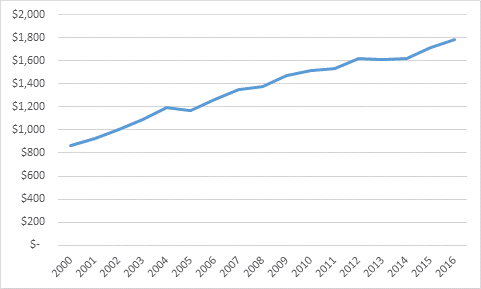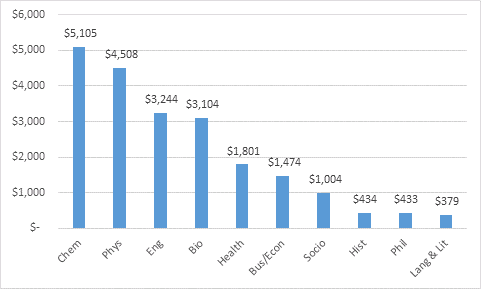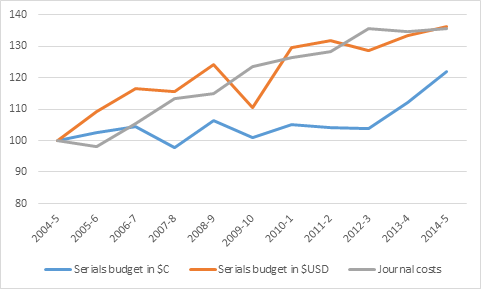Last week’s pieces on libraries generated a fair bit of comment (I get the impression librarians don’t get attention that often). So I thought I would come back for another pass on the subject.
First a couple of clarifications. First, apparently CARL’s data for UNB includes expenditures at both campuses while the student data relates only to the Fredericton campus. So all those per-student expenditure figures for UNB? They need to be cut by about 20%. Also, I think I need to underline that institutional spending varies so much because some libraries simply have much larger responsibilities than others. It’s not simply a matter of having greater student support buried in the Library, or doing more or less on open access repositories and the like. Some universities embed their archives in the Library, some take care of copyright issues, etc etc. So don’t treat all those comparisons from last Wednesday as full apples-to-apples; treat them as a starting point for discussions about cost, efficiency, etc.
But one discussion that kept cropping in the various replies to my piece last week had to do with journal prices. Everyone was happy to find that real expenditures on materials had climbed, but noted that this was nothing compared to the increase in journal costs, and might it be possible to show something a little more on that score?
As always on this blog: ask and ye shall receive.
The first challenge in keeping track of journal prices is that the manner of purchasing journals has changed considerably in the last 20 years. Universities used to buy individual journals; now they buy publisher-packaged bundles of journals. In theory, that brings average journal prices down (though not in a manner which is easy to track), but it keeps aggregate library expenditures high and rising. The second problem is that even to the extent one can track journal prices, one needs a stable basket of journals to use as an index and as far as I can tell there isn’t one. Library Journal has been doing a price survey for years, but it keeps widening the base of journals included in the index, so it’s not a perfect comparison over a long period of time. Still, it’s the best I could find and I took the data from its most detailed cost comparisons (the ones broken down by Library of Congress subject) since the year 2000. The result is shown below in Figure 1.
Figure 1: Average Journal Prices across all Library of Congress Fields of Study 2000-2016, (in 2016 USD)
Between 2000 and 2016, average journal prices in $USD rose by 107% after (US) inflation, or at roughly 5% per year. But this growth was not distributed equally across all fields of study. In recreation, the average increase was 417% (albeit from a pretty low base); in Anthropology it was a mere 64%. So an individual university’s lived inflation rate might vary quite a bit depending on the distribution of journal holdings across fields of study. The base level of expenditures will be quite different as well: as figure 2 shows, there are some quite significant differences in average journal prices by academic field.
Figure 2: Average Journal Prices for Top Ten Fields of Study by Journal Numbers 2016, (in USD)
Anyways, back to the issue of purchasing power. Obviously, journal costs are rising. But so too are universities serials budgets. Across all 31 Canadian Association of Research Libraries (CARL) members, which include 29 universities plus the Library and Archives Canada and the National Science Library, serials budgets rose 22% after inflation over the period 2004-5 to 2014-5. That’s more than the overall 9% increase in the materials budget, which implies that there has been a shift in purchasing from single titles to serials.
But since very few journals are published in Canada, overwhelmingly the most important number is not the serials budget in Canadian dollars, but the serials budget in American dollars. And here we lucked out, thanks to the resources-driven rise in the value of the dollar. In inflation-adjusted US terms, CARL members’ budgets increased collectively by 36% – which is exactly the same amount by which average journal prices increased over the same period. Meaning that, broadly speaking, Canadian universities were more or less able to keep pace over that period.
Figure 3: Changes in Journal Prices vs. Canadian Research Libraries’ Serials Budgets, 2004/5 to 2014/5, indexed to 2004/5
The problem of course is that since 2014, the dollar has sunk quite a bit – from 88 cents to 72 cents, or about 18%. And though we have no CARL statistics past 2014-15, I think it’s fair to say that serials budgets have not risen concomitantly. And so even without pressures like a 24% cut in provincial spending (as MUN has experienced), all institutions are likely to see some significant cuts in the few months if they have not already.
In short, a 5% per year real increase in journal fees can be dealt with by slimming monograph purchases if currency movements are in your favour. But if currency values are heading in the wrong direction, there’s almost nothing that can forestall serials cuts.




 Tweet this post
Tweet this post

So I think something got missed in the calculation of these numbers and the shift from 2000 to 2016 — a little thing called digital access. The move, in part, is to treat serial costs holistically — all formats, not just paper. Many (almost all?) universities now offer full online access to journals to ALL students by default, which comes at a cost — and is included in various budgets…some count it as a library cost writ large (like acquisitions), some count it as a university service, some count it as a systems cost (grouping all digital together), some count it as reference (tradition), and, more and more, some count it as serials. Which means many of those so-called “increases” in serials budgets are not necessarily apples:apples comparisons either because the subscriptions are managed by serials librarians instead of by systems librarians or reference librarians.
The other glitch is that for many universities, there’s a hidden cost behind the numbers…it also includes bindery costs. Many of those paper journals are still being bundled together, bound, and put in stacks at university libraries. Nobody knows why when the bindery cost could be offset by access in the EBSCO databases but it`s still being done. And that is often included in the serials cost, not the acquisitions or binding cost for singles.